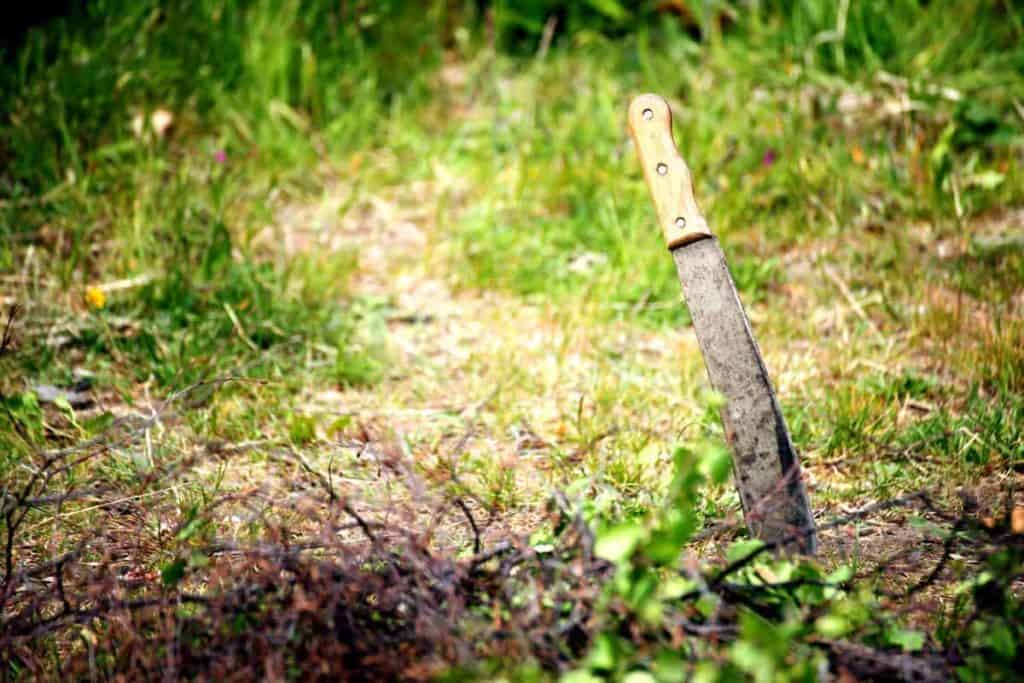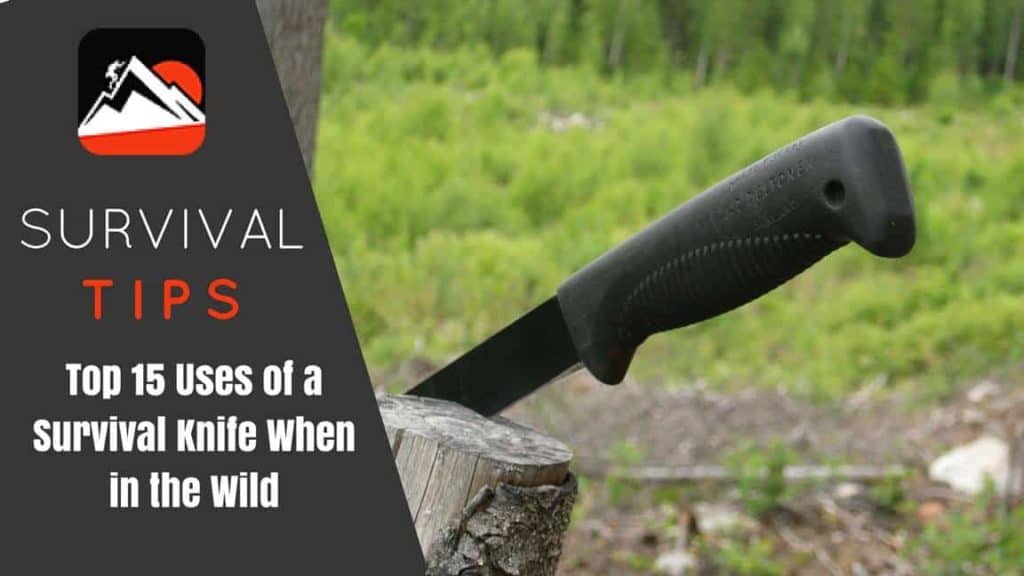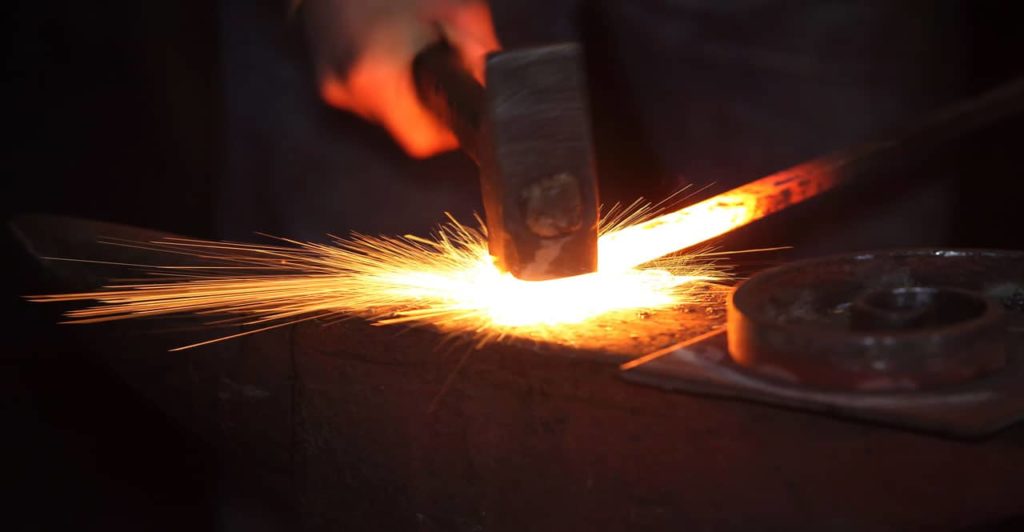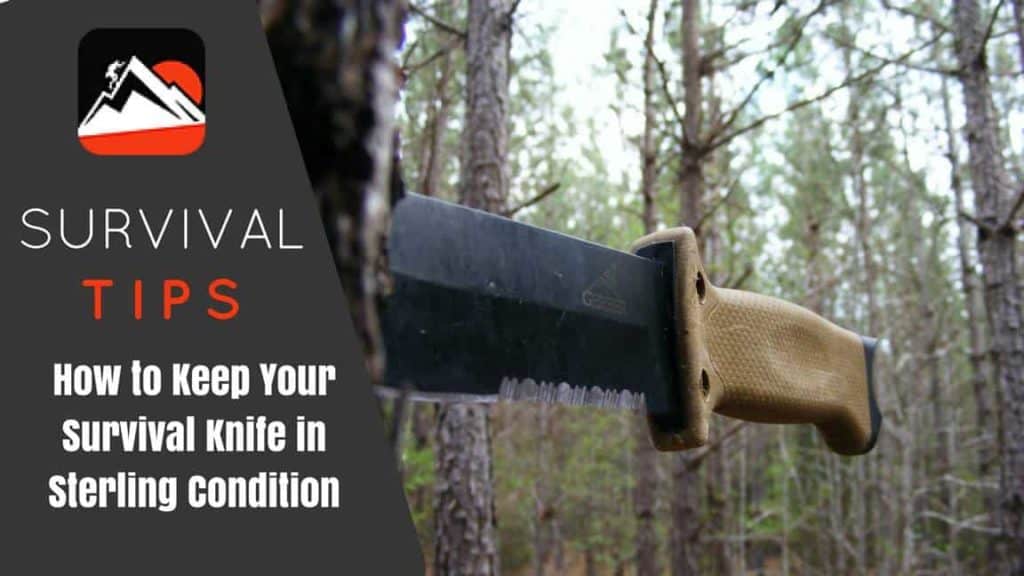Contents
Combining all the best elements of a small sword, a survival knife, and an axe, the machete is one of the most versatile of all outdoor tools. While many people still consider these simple, broad blades to be good for little more than hacking up coconuts or vines, new machetes designed specifically for preppers, campers, and survivalists are completely redefining the genre.
These “survival machetes” are built extremely tough, and boast features such as saw-tooth serrated edges, carbon coating, and modified blade designs. One look at one of these monsters, and it becomes quite apparent that they could be a great help in a variety of “tough spots.” Below,
HOW TO CHOOSE A GOOD MACHETE FOR SURVIVAL
Machetes are mean, nasty blades designed for rough work. That being said, they are still a tool, and tools are best used when their users have a specific purpose in mind. If you’re looking to simply clear brush or hack small branches, nearly any machete will do the job. However, if you want to saw through logs, chop hard objects, or effectively fend off attackers, you have to be more discerning.
Of course, there is a myriad of different machete designs, and not all of them are perfect for all tasks. In fact, even slight variations in blade length, design, weight, or features can mean a huge difference in performance. Below are some of the considerations you need to make before investing in a good survival machete.
THE IDEAL BLADE LENGTH
Most machete blades range between 14 and 36 inches long. Any shorter, and you have a large knife. Too much longer, and you have a sword. While there is no real “optimum” length for a machete, it can be safe to say that anywhere between 14 and 24 inches is where you see the highest effectiveness.
This is mainly because machetes are designed for rapid, repeat swinging. Within this optimum length, the weight of the handle and the heft of the blade make for a highly-efficient tool. As machetes are almost exclusively designed to be used one-handed, too long a blade means even the fittest user is going to tire quite quickly.
THE MOST VERSATILE MACHETE DESIGN
The machete is a global instrument, used for centuries everywhere from Africa to Southeast Asia to Central and South America. As different cultures and tribes adapted the tool to their surroundings, different blade designs began to appear. Today, these blade designs are incorporated in survival machetes of all kinds, but there remains a debate about which design is best for which task, and which is the most versatile overall.
Bolo – The Bolo blade is more about force than precision, allowing the user to hack through endless vegetation with ease. Its tip is sharp enough for piercing work, and it can also chop wood quite well.
Straight / Latin – The straight design features flat back and lightly-rounded, slightly broader tip. Great for clearing underbrush, this well-balanced blade doesn’t chop, but cuts its way through obstacles.
Panga – The panga blade is probably one of the most familiar machete shapes, resembling the profile of a canoe. The added weight at the tip makes for hard, heavy hits, perfect for chopping and cutting. Piercing of any kind, however, is extremely difficult.
Kukri – Kukri blades feature a weighted design that is tapered near the handle and larger at the end. This makes it good for chopping, piercing, and even precision cutting, but not necessarily hacking through brush. Features and quality aside, it is widely considered the most versatile design.
THE BOTTOM LINE
It’s impossible to hold up a blade and say “this is the world’s best survival machete.” However, as you can see, there are many factors that can be considered when attempting to identify which machete is best for you. In the following section, we’ll identify some of the best models on the market, discuss their features, and identify their pros and cons.
TOP 10 MACHETES AND THEIR BEST USES
1. ODENWOLF W Machete
![Gerber Bear Grylls Parang Machete [31-002289]](https://survivorsfortress.com/wp-content/uploads/2023/12/Screen-Shot-2023-12-31-at-12.18.41-PM-1024x960.jpg)
The Odenwolf W Machete is one design in a number of items from Odenwolf. Trying to be a perfect outdoor tool, this machete has a number of features that help it stand out against the competition.
The full tang construction helps ensure a full blade and handle act as one, and the Parang design helps ensure that the angled blade will have ferocious chopping power. The blade utilized D2 steel to enhance strength, resist corrosion, and ease the sharpening process.
All in all, this affordable Parang should perform well in most survival situations – including defense. However, if you’re looking to chop enough heavy wood to build a log cabin with it, you’re probably going to encounter problems once you get to 3” or 4” branches. For the yard, however, it should be a savage and useful tool if kept dry and oiled regularly.
Specifications:
Steel: Unknown
Blade: 13.5”
Overall: 19.5”
| PROS | CONS |
|---|---|
| (+) Angled blade for more powerful strikes. | (-) Shorter blade |
| (+) TPE grip is comfortable | |
| (+) D2 Steel blade. |
2. SOG SOGFARI MACHETE MC02-N

The SOG SOGfari Machete MC02-N is a long, sharp, beast of a straight / Latin designed for heavy use, but not necessarily the heavy woods. With a long tooth serrated edge on the back for sawing and an 18” blade on the front, the manufacturer claims this saw is ready to pull its weight in lots of situations, survival included.
The first thing that stands out on this machete is the unique and rather clever saw-backed design. From a survival standpoint, having to carry two large tools for one wood cutting job could be cumbersome or even dangerous, so providing the saw is effective, it’s a useful implement. The spike on the back of the full tang is another feature I like, as it could be used for pounding and scraping, making this machete more of a “multi-tool.”
Unfortunately, the saw not only cuts on the back pull, which is a time eater, but it also poses a bit of a risk considering the length of the blade itself. If hitting something too hard, the added force from tip of the blade may cause bounce back right into the face of the user. Some owners of this blade also complain of the steel being too low grade for heavy jobs, and some chipping has been reported.
All in all, it’s a cool idea that will more than likely prove quite useful for some users who want a multi-purpose machete. How effective it would be in a survival situation remains to be seen.
Specifications:
Steel: 3CR13 stainless
Blade: 18”
Overall: 29.95”
| PROS | CONS |
|---|---|
| (+) Large tooth serrated saw on the back. | (-) Saw could pose a danger to users. |
| (+) Spiked tang on the back of the handle. | (-) Blade is a bit too light for firewood or hacking thick brush |
| (+) Long length for cutting at distance. | (-) Sheath snags on the teeth and can cause injuries. |
Check out our recommended survival knives article.
3. CRKT CHANCEINHELL FIXED BLADE MACHETE

The CRKT Chanceinhell Fixed Blade Machete is one of very few machete-sized blades to owe its creation to esteemed knife designer Ken Onion. Coming in several sizes, including the 16” full size, this stunning-looking blade is MN65 steel with an anti-corrosion powder coat, which the manufacturer claims can handle all weather conditions and “all woods” situations.
First off, Ken Onion’s design of this blade is absolutely amazing – it almost looks too good to consider mucking it up in the bush. Still, with a razor-sharp edge, this thin, light machete should perform quite well in situations where it is not used in place of an axe. It seems like it’s shorter size would make it an ideal tactical or EDC machete, though it might be too long for belt carry.
Unfortunately, at a max blade length of 16”, this is more of a knife than a machete. Some users, while praising the beautiful design of this piece, have said that this absolutely cannot be used for any heavy chopping or it will simply break. Other complaints include the handle, which features loose pins that may not alight – making inserting a lanyard difficult – and can get quite slippery.
If your idea of a survival machete is one that you’ll use almost exclusively for clearing brush and small trees, the Chanceinhell will likely perform admirably. If you want an all-purpose tool that can hack, slash, saw, and chop, you’re going to need something with a thicker blade and a heftier design.
Specifications:
Steel: MN65
Blade: 12” or 16”
Overall: 22”
| PROS | CONS |
|---|---|
| (+) Designed by Ken Onion, a renowned knife designer and specialist. | (-) A little too thin and too light for heavy duty use. |
| (+) Thin and light for easy handling. | (-) Pins in the handle are not anchored, and may be off-center. |
4. SCHRADE SCHKM1 KUKRI MACHETE

The Schrade SCHKM1 Kukri Machete is a swift and sleek kukri-esque blade designed for speed hacking through rough and tumble vegetation and light chopping. Boasting 3Cr13 Steel and a 13.3” blade, the SCHKM1 is small and light enough to carry and use all day, but solidly-built enough to clear almost everything in its way.
The thing that stands out the most on this design are the “speed holes,” which the manufacturer claims helps reduce drag – and therefore fatigue – when the SCHKM1 is being swung repeatedly. Another interesting choice here is the steel, which is much softer than many modern machetes are using, and should help it withstand high impact use without chipping.
One major complaint when it comes to this model is the sheath, which is floppy and soft. This may seem cosmetic at first, but it also means that sheathing this machete one-handed will be nigh impossible and actually quite dangerous. What is most concerning, however, is that a number of users have complained of broken blades after hardly any use, which could signal a quality control issue in the factory.
Potential QC issues aside, there are many outdoorsmen who are perfectly happy with their SCHKM1, and find it a versatile, if not heavy duty, machete. In terms of its abilities as a survival tool, it would most likely be used in situations where only vascular plants or light branches needed to be cut. As for defending the homestead, it would definitely be applicable in a threatening situation.
Specifications:
Steel: 3Cr13 Steel
Blade: 13.3”
Overall: 19.7”
| PROS | CONS |
|---|---|
| (+) Speed holes reduce air resistance and keep the weight down. | (-) Cheap sheath could pose a health hazard. |
| (+) Softer steel to reduce the risk of chipping. | (-) Blades breaking quite early on have been reported. |
| (+) Good handle design maximizes grip retention. |
Learn more about the best bushcraft knives by clicking here.
5. KERSHAW CAMP 14 (1076)
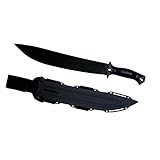
The Kershaw Camp 14 (1076) is a full tang, “hard use” machete made of tough 65Mc Carbon Tool Steel. Specifically designed to be put to work outdoors, the 14” blade is sealed with a black powder coat to resist corrosion, rust, and wear.
Like many Kershaw products, this machete is designed for versatility. This is particularly apparent in the multi-carry sheath and grip, but the blade itself looks like it can handle both cutting and slashing with equal efficiency. Users report that this short machete feels really great in hand, and has an excellent weight that makes it quite effective against harder objects. As an added bonus, the Kershaw can do the powder coat in different colors for collections who want to put the blade on display.
However, according to some users, the Kershaw is not only too short to function as a “true machete,” but it is too heavy as well, and will quickly tire the user out when swung repeatedly. Others have taken issue with “full tang” claim, saying that it is actually a “fixed blade” design that does not entirely pass through the handle. Others say that batoning with it is not recommended as the steel is just too unreliable
For those who want a big knife with some nice features, the Kershaw should function quite well. How useful it would be as an actual survival machete, however, remains in doubt after reports of inferior steel and the blade snapping during batoning. Address these issues, and Kershaw should have a pretty reliable outdoor tool on their hands.
Specifications:
Steel: 65Mn Carbon Tool Steel
Blade: 14”
Overall: 20”
| PROS | CONS |
|---|---|
| (+) Designed to be put to work. Built tough. | (-) Too heavy to function as a true machete. It will tire you out. |
| (+) Versatile grip and sheath design. | (-) More of a fixed blade than full tang according to some. |
| (+) Optional colored powder coat. |
6. GERBER GATOR BOLO MACHETE
![Gerber Gator Bolo Machete [31-002076] Gerber Gator Bolo Machete [31-002076]](https://images-na.ssl-images-amazon.com/images/I/31VEbXpCk4L._SL160_.jpg?tag=survivorsfo01-20)
The Gerber Gator Bolo Machete takes its design from the Philippines, a region of Southeast Asia known for thick, unwieldy jungle. As such, the 15.5” blade carries a lot of weight in the dramatically bulged tip, which offers lots of extra power in each swing.
The most notable thing about the Gator Bolo is its shape, with the massive bulge on the end of the design making it look big and nasty and ready for the woods. This design adds so much power, that many claim they use this machete as an axe with no problems. Many buyers have also complimented the handle, which is virtually slip-proof and very comfortable. According to everyone that’s used it, the Bolo is not heavy to hold but offers very heavy results when you swing it.
On the downside, many users have complained that the blade needs to be well-oiled after EVERY use to avoid rusting. Some knife owners will consider this a given, but others may find it a cumbersome chore. There have also been reports of the Gator bending too easily in some situations, leaving users regrinding it quite often. Others note that the handle is a bit too small for some to get an excellent grip and swing.
All things considered, this Bolo should be able to take whatever you throw at it with little problem, assuming that any reports of “inferior steel” can be chalked up to QC issues or user error. I love that it’s compact enough to be carried everyday and everywhere, and the fact that it can more or less replace an axe in most situations makes a good contender for a great survival machete.
Specifications:
Steel: 1050 Steel
Blade: 15.5”
Overall: 22.5”
| PROS | CONS |
|---|---|
| (+) Bulge at the end offers axe-like power. | (-) Blade will rust if not oiled after every use. |
| (+) Based on a thick jungle design from the Philippines. | (-) Steel quality has come into question. |
| (+) Compact enough for you to carry it every day. |
7. KA-BAR 2-1249-9 KUKRI

The KA-BAR 2-1249-9 Kukri is a short machete blade designed for precision and maneuverability. Many claim that the 11.5” blade design allows the KA-BAR to function as a sort of “knife-axe,” hacking and slashing through undergrowth with little effort. Its compact size is also not lost on self-defense enthusiasts, who know what kind of effect a design like this would have in a self-defense situation.
The first thing that stands out about this Kukri is the great use of the traditional blade design in a much shorter, stouter knife. This means lots of leverage in the swing without the user getting too tired too quickly. The epoxy coating gives it a jet-black finish, and should do the trick of protecting against rust, corrosion, and wear. I also like that the manufacturer has gone with a softer steel here so that it won’t chip. If it rolls, it can always be resharpened.
On the other hand, some users think this design is just a little too short for use in dense bush, as the whole point of a machete is to be able to clear large swaths of growth in a single swing. Others feel it is a bit too heavy for its small size, which limits its ability to be carried comfortably. The biggest complaint, however, is that the curve of the blade just makes it too difficult to sharpen.
If you are looking for a handy backyard tool, this could be quite effective. However, as for going into thick bush, a longer, more reliable design might be of better use.
Specifications:
Steel: 1085 Carbon Blade Steel
Blade: 11.5”
Overall: 17”
| PROS | CONS |
|---|---|
| (+) Kukri blade increases the force of impact dramatically. | (-) Hard to sharpen due to the curve of the blade. |
| (+) Short size offers precision and maneuverability. | (-) Too heavy for hiking and everyday carry. |
| (+) Softer steel to resist chipping. |
8. SCHRADE SCHMBSCP MACHETE

The Schrade SCHMBSCP Machete features a versatile blade made out of 3Cr13 steel and ringing in at just over 16 inches. It features a corrosion-resistant powder coating and a slightly “tip heavy” design to add a bit more power to the user’s swing.
The slight bulge at the end of the blade is a great design feature, as it is not large enough to be cumbersome in the bush but will still add significant weight and power to a strike. The grip design of this blade is another excellent feature, as it is both ergonomic and really guards the user’s hand against slipping forward in the event of the blade sticking when piercing. The lighter, thinner blade also means that this design will be able to handle some precision tasks as well as chopping and clearing brush.
Many users have noted that Schrade’s design is much more similar to a short sword than a machete. This goes beyond the looks as well, as some sites even list it as a sword, and the blade features far less flex than a machete. By far the most prominent complaint is that this design lacks any piercing ability at all, with the tip being very very fine. Some have claimed that the tip simply broke off when they attempted to pierce a moderately hard object.
Overall, the Schrade looks great and – in theory – should function quite well in a hacking and slashing situation. However, once one gets past vines and small branches, they might see a severe loss of performance – particularly when attempting to chop or pierce. If you’re looking for a blade that will spend most of its time doing light work around a camp, this should do the trick. If you’re looking for a workhorse, this probably isn’t it.
Specifications:
Steel: 3Cr13
Blade: 16.1”
Overall: 22.6”
| PROS | CONS |
|---|---|
| (+) Can handle some precision work. | (-) Weak tip – no ability to pierce. |
| (+) Slight bulge at the end of the blade adds power to strike. | (-) More of a sword than a machete. |
| (+) Great grip with well-designed finger guard. |
9. COLD STEEL ROYAL KUKRI MACHETE

The Cold Steel brand prides itself of manufacturing serious blades for serious situations. In the case of this modified Kukri, the designers have gone completely back to the drawing board to craft
a machete that really draws upon the original concept to offer major chopping power. According to the manufacturer, this machete is explicitly designed for “bushcraft.”
Thanks to the unique shape, this Cold Steel should offer better thrusting and piercing power than other Kukri blades. I also really like the large finger protecting handle guard built right into the blade, leaving almost no potential for failure at all. According to many users, this is a steal as it looks, performs, and handles much like Cold Steel’s far more expensive machete models.
This design is not as heavy as a true Kukri, which could take some of the power out of the chop despite the more accented curve. The design has also proved to be a little forward heavy for some users, with some thinking a blade this sharp should be weighted a bit more evenly to prevent accidents.
The people at Cold Steel are martial artists, and that shows a lot in their blade designs. In the case of a survival machete, this is not necessarily a bad thing, as self-defense is a viable potential use for any blade in a survival situation. All in all, this would be a great campsite or backpack companion, but it probably won’t be cutting down trees.
Specifications:
Steel: 1055 Carbon Steel
Blade: 15.5”
Overall: 22.5”
| PROS | CONS |
|---|---|
| (+) Better thrusting and piercing power than other Kukri designs | (-) Not as “hefty” as a true kukri |
| (+) Designed specifically for “bushcraft” | (-) A little too forward-heavy for some |
| (+) Large finger protecting handle guard built into the blade |
10. COLD STEEL 97BAM18S MACHETE

The Cold Steel 97BAM18S Machete is a “Barong” style design, which was originally designed for a dual purpose – farming and warfare. As a result, this 24.5” machete offers some pretty deadly features, which the manufacturer claims will serve the user in many survival situations, not just clearing a path.
The most notable feature of the 97BAM18S s it’s long, thin design and flat, almost saber-like blade. Another feature is the downturned handle, which anchors the blade in the hand and helps resists centrifugal forces, protecting the user from potential injury. The wide leaf shape of the blade offers a bit of extra weight, which should prove useful when cutting through the underbrush.
To be clear, however, this is much more weapon than tool, and the complete lack of gripping on the handle and finger guard makes this machete quite dangerous to use as a machete.
If you’re looking for a self-defense tool that can cut a few branches here and there, this is a good investment, but if you want a real, functional machete, you’re going to want to look elsewhere unless you’re sticking to your backyard.
Specifications:
Steel: 1055 Carbon Steel
Blade: 18”
Overall: 24.5”
| PROS | CONS |
|---|---|
| (+) Barong style was designed for farming and warfare | (-) Dangerous handle. Complete lack of texturing. |
| (+) Downturned handle anchors the blade in the hand of the user. | (-) More weapon than tool. |
| (+) Wide leaf shape adds weight and effectiveness. |
CONCLUSION
Having looked at a range of popular modern machetes on the market, it’s clear that not every manufacturer has the same features in mind when designing “survival machetes.” This puts the burden largely on the user, who will have to consider shape, weight, length, design, and steel type to decide what type of machete best fits their location, and any potential survival situations they might encounter.
In the end, the best survival machete is the one that fits your particular needs, and delivers what you need when you want it.
If you’ve come across any particularly effective survival machetes, feel free to e-mail us so we can profile them here.

